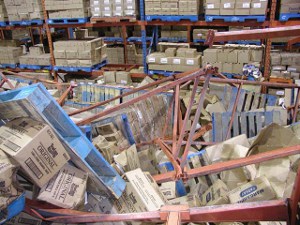With more than 4,600 deaths in 2012 alone, the warehouse environment is frequently cited as one of OSHA’s high-risk working environments.
Due to the constant wear and tear of heavy loads, machinery and operations changes your racks may sustain damages that go dangerously unnoticed. One of the best steps you can take to prevent injury and avoid hefty OSHA fines is to frequently inspect your pallet racks for damage. Should you suspect a possible problem, it’s important to address it immediately in order to mitigate potentially detrimental safety hazards.
But should you save your warehouse the disruption and repair the issue or play it safe and replace the entire rack? Let’s investigate.
What are the top causes of pallet racking damage?

When a pallet rack gets damaged, it’s commonly caused by one of the following: forklift damage, racks that have been overloaded, operational changes not supported by the design, damage from equipment that has been used incorrectly, money-saving tactics like purchasing a rack with reduced capacity, faulty equipment, racks with altered configurations and/or mixed manufacture component combinations.
What should I look for during a rack inspection?
Be thorough in your visual inspections and look for any of the below. If you see signs of potential damage, immediately unload the inventory, flag the rack and assess whether a repair or replacement is in order.
• Tilted or misalignment beams & racks
• Overloaded or misloaded racks
• Rust or corrosion
• Bent or damaged uprights & beams
• Incorrect beam hardware or faulty attachments
How do I know when I need to take action on a damaged rack?
First, assess the degree of damage; the severity is often characterized by dents, buckles, twists, tears or splits. For example, as dents grow more than ½” deep of the face of the upright, if you begin to see tears in the steel, etc it’s time to act.
Is it better to repair my pallet rack instead of replacing it?
Some benefits of repairing your racks include:
• Limited warehouse disruption to your workflow.
• Less loading and unloading if only installing new parts.
• Same pallet rack repair kit may be used on damages at similar heights.
• An easier option when repairing damage mid-row.
• Can be less expensive than shipping new uprights, especially when custom or very tall.
How do I know when replacing my rack is the only option?
Sometimes replacement is the only safe option. Some scenarios include:
• When the front or back of your rack has sustained significant damage.
• There is varied placement of damage in multiple areas and heights.
• Inexpensive replacement of standard build, standard height racks.
• If you may be changing facilities anyway new racks may fare better.
Ultimately, the decision to repair or replace your racks hinges largely on the scope of the damage. The most important take away? Use regular rack inspections to provide the necessary information you need to keep your warehouse operations running as safely as possible.
